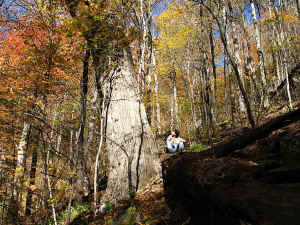---------- Forwarded message ----------
From: Jess Riddle
Date: Nov 30, 2005 10:21 PM
Subject: Rocky Face Mountain, GRSMNP, TN
A few weeks ago, Michael Davie and I explored a cove on the
north side
of Rocky Face Mountain and walked along Cosby Creek in the
northeastern part of the Smokies. Rocky Face Mountain juts west
off
of the main ridgeline of the Smokies. Tributaries of Toms Creek,
and
one tributary of Cosby Creek, drain the steep north side of the
mountain/ridge while the main stem of Cosby Creek flows at the
other
foot of the mountain. West of the ridge, extensive flats along
both
creeks supported settlers until the formation of the park. Dense
stands of tuliptrees, often around 120' tall, now populate those
old
fields.

The large northern red oak above Cosby Creek - photo by
Michael Davie
The narrow cove we went up was too steep and rocky for
productive
agriculture. However, adjacent farmers likely removed white ash
and
tuliptree from the cove leaving sugar maple and yellow buckeye
to
dominate. Slender silverbells also occupy much of the canopy,
and
declining yellowwood remain scattered in midstory positions.
Hemlocks
entered the mix along the edge of the cove and at the top where
yellow
birch, black cherry, and chestnut debris occurred. An 11'3"
x 130.4'
yellow buckeye appeared to slightly surpass the sugar maples as
the
tallest tree in the cove. Sugar maples reached comparable
circumferences with 11'5" x 123.4' and 10'3" x 128.4'
trees being
among the largest, but a stout 14'6" hemlock had the
largest trunk of
any tree in the cove. A yellowwood with a 9'2" cbh and
60.7' height
set a new park diameter record.
The dryness of the south side of the ridge stood in stark
contrast to
the north side. The slope plunged down at approximately 40
degrees,
but had only small rock outcrops. Pines, table mountain near the
top
and pitch lower down, mixed with chestnut oak and red maple to
form
most of the canopy over a continuous mountain laurel understory.
During the last series of droughts, pine beetles killed many of
the
most of the mature pines; several areas of young, live pines
remained.
Although the slope was never cut, no species reached great age.
These harsh conditions made the presence of one fertile cove
quite
surprising. The rocky, southwest-facing cove harbored mature
sugar
maple, yellow buckeye, bitternut hickory, and basswood. A small
clump
of northern red oaks on the edge of the area included an
impressive
17'2" x 110.6' individual.
While the forest was not a pure tuliptree stand, the even young
age of
the trees and rock wall gave clear evidence that settlement had
occurred at least briefly on the Cosby Creek at around 3400'
elevation. The road to that farm provided means for removing the
most
valuable trees from the creek-side down to the farming community
around 2600'. A swath of rich cove forest continuously lined the
creek within a matrix of hemlock dominated forest. Impressive
remnant
trees left along the creek included a 14'10" yellow
buckeye, a 12'5"
sugar maple, and a 14'6.5" x 135.9' hemlock. Roughly 14'
cbh
tuliptrees still lurked around the edges of the rich cove
forest, and
hinted that much larger trees were removed.
Farther down Cosby Creek in an area that was cleared but not
farmed
grows a 4'8" x 115.5' silverbell. The other tree measured
during the
day was a 1'2" x 39.7' winged sumac in the NPS Foothills
Parkway East
unit.
Jess Riddle & Michael Davie
|